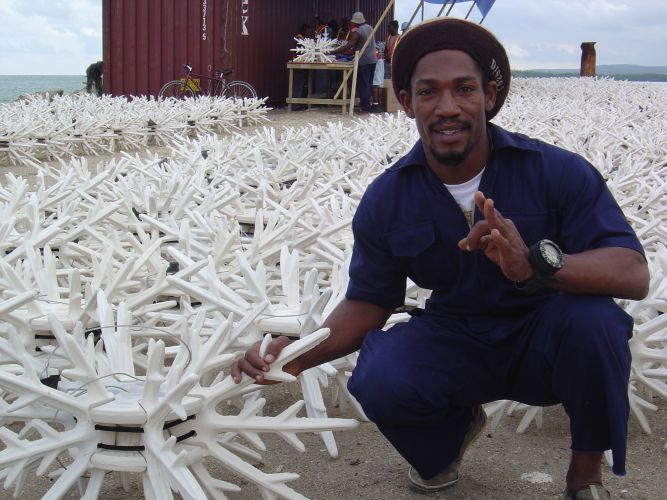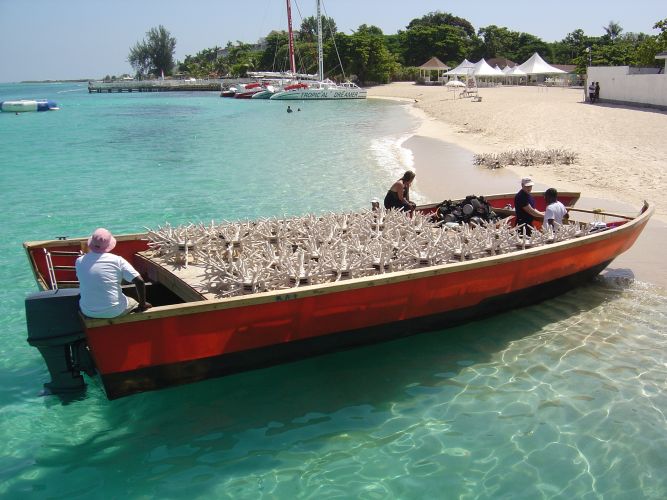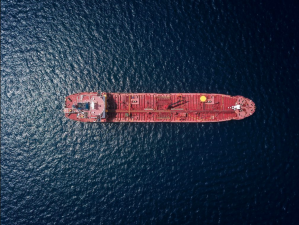 Installed already in Qatar, reef recovery time can be decreased from 50 to 100 years to 7 to 15 with these ceramic antler-like artificial reefs.
Installed already in Qatar, reef recovery time can be decreased from 50 to 100 years to 7 to 15 with these ceramic antler-like artificial reefs.
One of the great dilemmas for marine protected areas is ensuring marine ecosystems overcome issues related to “shifting baselines”: the extent to which marine areas have been driven from their “natural baseline state” due to anthropogenic activity and natural changes. Unfortunately, conservation plans often select baselines that already represent a disturbed state. The result is a continuous decline in ecosystem integrity, as next generations of managers resets their baseline to even lower marine ecological states. A partial solution to this is restoration – an active form of conservation. However coral reef restoration (either as coral reef art or ugly electric cages) been no easy task given the lengthy period of time it takes for corals to grow – between 0.06 to 3.9 cm a year.
Thankfully, a new product called EcoReef has been on the market and it is showing to be an effective coral reef restorer that could work for the Middle East reefs in the Gulf and the Red Sea.
Ecoreef is a patented ceramic rock structure that is easily assembled together and anchored to the seafloor (see above). Their antler like shape mimics the staghorn growth of certain Acroporas while providing the foundations for algae and coral to colonize the structure and intricate channels to protect juvenile fish.
There are many benefits to EcoReefs. First, the modules are made from ceramic, an ideal material because it is pH neutral, non-toxic and chemically inert in seawater. Although initially they may seem like strange “foreign” structures covering the sea bed, over time corals and other invertebrates fill in and overtop the structure to complete the living reef and amazingly recreate a natural setting (although not original) that attracts fish and restores an ecosystem in an area which has been sadly pulverized by blast fishing or scraped by trawlers.
It is estimated that with these ceramic structures the recovery time of pulverized reefs can be reduced from 50 to 100 years to just 7 to 15 years. this is extremely good news for marine conservationists.
Second, EcoReefs projects are highly cost-effective and relatively easy to scale and assemble on the field. According to the website, EcoReefs provides more habitat for more organisms at a lower cost per organism compared to other common artificial reefs (tires, biorock, coral nubbins, rock piles) lowering the per unit cost to $2.10 compared to $31.80 for tire reefs.
This superior performance is attributed to the high amount of useable surface area per EcoReefs module (1.27m2) combined with the high suitability of ceramic for invertebrate settlement.
Finally Ecoreefs are easy to assemble and transport in the sea using smaller and low- impact boats.
Seacology and EcoReefs have worked collaboratively to restructure the reefs of Manado Tua Island, in Indonesia, which were completely wiped out in 2003 and have since then recovered. This short clip below shows how EcoReef has aided restoration for the benefit of the local community and ecosystem – it would be nice to see this introduced in the evolving Marine Protected Areas of the Red Sea and the Gulf of Aden.
[youtube]http://www.youtube.com/watch?v=SvKgHal5MNM[/youtube]
EcoReefs has been used for the first time in the Middle East by Dolphin Energy in Qatar, as part of their corporate social responsibility projects, to restore local reefs.
Ahmed Ali al-Sayegh, CEO Dolphin Energy says: “EcoReefs installations slow water currents, shelter the small fish which keep coral clean and alive, and provide the necessary micro-environments for successful coral growth. Dolphin is pleased to have sourced a system that will contribute sensitively and positively to the marine environment in which we work.”
Notwithstanding this good news, we must avoid a situation whereby solutions such as Ecoreefs legitimize reef destruction with the excuse that they can easily restore. Once destroyed, reefs can never return to their original state and although they may “look” healthy , many of the ecosystem processes may not be restored, not even with EcoReefs.
::EcoReef





Comments are closed.